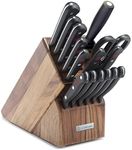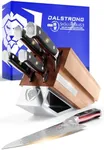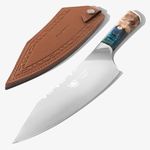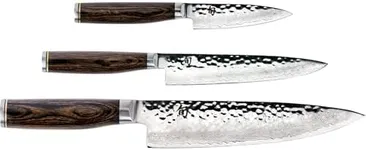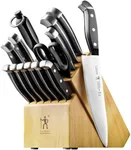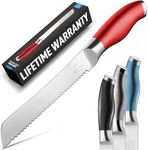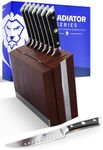Buying Guide for the Best Kitchen Knifes
Choosing the right kitchen knife can significantly enhance your cooking experience. A good knife should feel comfortable in your hand, be sharp enough to make precise cuts, and be durable to withstand regular use. When selecting a kitchen knife, consider the type of cooking you do most often and the specific tasks you need the knife to perform. Here are some key specifications to consider when picking the best kitchen knife for you.Blade MaterialThe blade material of a kitchen knife affects its sharpness, durability, and ease of maintenance. Common materials include stainless steel, carbon steel, and ceramic. Stainless steel is resistant to rust and easy to maintain, making it a popular choice for everyday use. Carbon steel is known for its sharpness and edge retention but requires more care to prevent rust. Ceramic blades are extremely sharp and lightweight but can be brittle and prone to chipping. Choose a blade material based on your preference for maintenance and the type of cutting tasks you perform.
Blade TypeThe type of blade determines the knife's suitability for different tasks. Common blade types include straight edge, serrated edge, and granton edge. Straight edge blades are versatile and ideal for precise cuts, making them suitable for chopping vegetables and slicing meat. Serrated edge blades are perfect for cutting through tough or crusty surfaces like bread. Granton edge blades have dimples along the side to prevent food from sticking, making them great for slicing meats and cheeses. Consider the types of food you prepare most often to choose the right blade type.
Blade LengthBlade length affects the knife's maneuverability and the types of tasks it can perform. Common lengths range from 6 to 12 inches. Shorter blades (6-8 inches) are easier to control and ideal for tasks like peeling, trimming, and slicing small fruits and vegetables. Medium blades (8-10 inches) offer a balance of control and versatility, suitable for most kitchen tasks. Longer blades (10-12 inches) are great for slicing large cuts of meat and chopping large vegetables but can be harder to handle. Choose a blade length based on your comfort and the size of the food you typically prepare.
Handle MaterialThe handle material affects the knife's comfort, grip, and durability. Common materials include wood, plastic, and composite. Wooden handles offer a traditional look and comfortable grip but require more maintenance to prevent damage from moisture. Plastic handles are lightweight, easy to clean, and resistant to moisture, making them a practical choice for everyday use. Composite handles combine the benefits of wood and plastic, offering durability and comfort. Choose a handle material that feels comfortable in your hand and suits your maintenance preferences.
Weight and BalanceThe weight and balance of a kitchen knife affect its ease of use and control. A well-balanced knife should feel comfortable and stable in your hand, with the weight evenly distributed between the blade and handle. Heavier knives provide more power for cutting through tough ingredients but can be tiring to use for extended periods. Lighter knives offer better maneuverability and are easier to handle for delicate tasks. Consider your strength and the types of tasks you perform to choose a knife with the right weight and balance for you.



